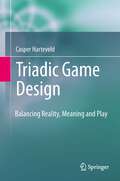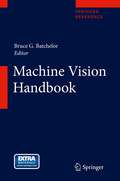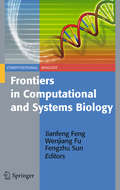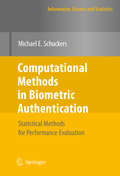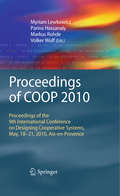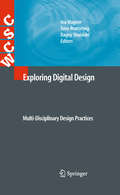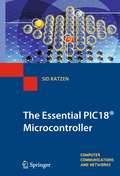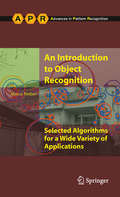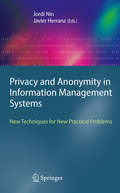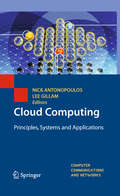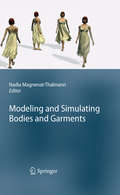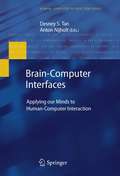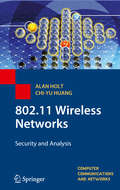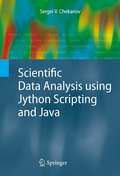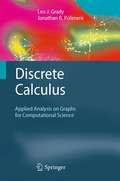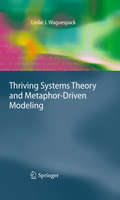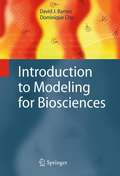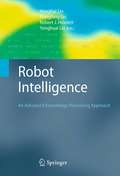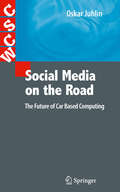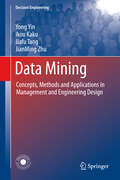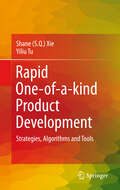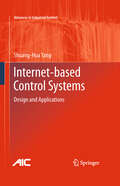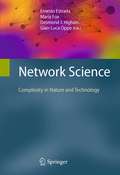- Table View
- List View
Triadic Game Design
by Casper HarteveldMany designers, policy makers, teachers, and other practitioners are beginning to understand the usefulness of using digital games beyond entertainment. Games have been developed for teaching, recruiting and to collect data to improve search engines. This book examines the fundamentals of designing any game with a serious purpose and provides a way of thinking on how to design one successfully. The reader will be introduced to a design philosophy called "Triadic Game Design."; a theory that all games involve three worlds: the worlds of Reality, Meaning, and Play. Each world is affiliated with aspects. A balance needs to be found within and between the three worlds. Such a balance is difficult to achieve, during the design many tensions will arise, forcing designers to make trade-offs. To deal with these tensions and to ensure that the right decisions are made to create a harmonic game, a frame of reference is needed. This is what Triadic Game Design offers.
Machine Vision Handbook
by Bruce G. BatchelorThe automation of visual inspection is becoming more and more important in modern industry as a consistent, reliable means of judging the quality of raw materials and manufactured goods . The Machine Vision Handbook equips the reader with the practical details required to engineer integrated mechanical-optical-electronic-software systems. Machine vision is first set in the context of basic information on light, natural vision, colour sensing and optics. The physical apparatus required for mechanized image capture - lenses, cameras, scanners and light sources - are discussed followed by detailed treatment of various image-processing methods including an introduction to the QT image processing system. QT is unique to this book, and provides an example of a practical machine vision system along with extensive libraries of useful commands, functions and images which can be implemented by the reader. The main text of the book is completed by studies of a wide variety of applications of machine vision in inspecting and handling different types of object.
PEM Fuel Cells with Bio-Ethanol Processor Systems
by Rachid Outbib Diego Feroldi Marta S. BasualdoAn apparently appropriate control scheme for PEM fuel cells may actually lead to an inoperable plant when it is connected to other unit operations in a process with recycle streams and energy integration. PEM Fuel Cells with Bio-Ethanol Processor Systems presents a control system design that provides basic regulation of the hydrogen production process with PEM fuel cells. It then goes on to construct a fault diagnosis system to improve plant safety above this control structure. PEM Fuel Cells with Bio-Ethanol Processor Systems is divided into two parts: the first covers fuel cells and the second discusses plants for hydrogen production from bio-ethanol to feed PEM fuel cells. Both parts give detailed analyses of modeling, simulation, advanced control, and fault diagnosis. They give an extensive, in-depth discussion of the problems that can occur in fuel cell systems and propose a way to control these systems through advanced control algorithms. A significant part of the book is also given over to computer-aided engineering software tools that can be used to evaluate the dynamic performance of the overall plant. PEM Fuel Cells with Bio-Ethanol Processor Systems is intended for use by researchers and advanced students on chemical, electrical-electronic and mechanical engineering courses in which dynamics and control are incorporated with the traditional steady-state coverage of flowsheet synthesis, engineering economics and optimization.
Frontiers in Computational and Systems Biology
by Jianfeng Feng Wenjiang Fu Fengzhu SunThis unique volume surveys state-of-the-art research on statistical methods in molecular and systems biology, with contributions from leading experts in the field. Each chapter discusses theoretical aspects, applications to biological problems, and possible future developments. Topics and features: presents the use of thermodynamic models to analyze gene regulatory mechanisms; reviews major algorithms for RNA secondary structure prediction; discusses developments in the area of oligo arrays; examines the application of models of stochastic processes in nonequilibrium thermodynamics and biological signal transduction; describes phylogenetic footprinting methods for TFBS identification; introduces penalized regression-based methods for constructing genetic interaction or regulatory networks; investigates the specific role played by irreversible Markov processes in modeling cellular biochemical systems; explores the concept of gene modules in a transcriptional regulatory network.
Computational Methods in Biometric Authentication: Statistical Methods for Performance Evaluation (Information Science and Statistics)
by Michael E. SchuckersBiometrics, the science of using physical traits to identify individuals, is playing an increasing role in our security-conscious society and across the globe. Biometric authentication, or bioauthentication, systems are being used to secure everything from amusement parks to bank accounts to military installations. Yet developments in this field have not been matched by an equivalent improvement in the statistical methods for evaluating these systems. Compensating for this need, this unique text/reference provides a basic statistical methodology for practitioners and testers of bioauthentication devices, supplying a set of rigorous statistical methods for evaluating biometric authentication systems. This framework of methods can be extended and generalized for a wide range of applications and tests. This is the first single resource on statistical methods for estimation and comparison of the performance of biometric authentication systems. The book focuses on six common performance metrics: for each metric, statistical methods are derived for a single system that incorporates confidence intervals, hypothesis tests, sample size calculations, power calculations and prediction intervals. These methods are also extended to allow for the statistical comparison and evaluation of multiple systems for both independent and paired data. Topics and features: * Provides a statistical methodology for the most common biometric performance metrics: failure to enroll (FTE), failure to acquire (FTA), false non-match rate (FNMR), false match rate (FMR), and receiver operating characteristic (ROC) curves * Presents methods for the comparison of two or more biometric performance metrics * Introduces a new bootstrap methodology for FMR and ROC curve estimation * Supplies more than 120 examples, using publicly available biometric data where possible * Discusses the addition of prediction intervals to the bioauthentication statistical toolset * Describes sample-size and power calculations for FTE, FTA, FNMR and FMR Researchers, managers and decisions makers needing to compare biometric systems across a variety of metrics will find within this reference an invaluable set of statistical tools. Written for an upper-level undergraduate or master's level audience with a quantitative background, readers are also expected to have an understanding of the topics in a typical undergraduate statistics course. Dr. Michael E. Schuckers is Associate Professor of Statistics at St. Lawrence University, Canton, NY, and a member of the Center for Identification Technology Research.
Proceedings of COOP 2010
by Myriam Lewkowicz Parina Hassanaly Volker Wulf Markus RohdeCOOP 2010 is the 9th edition of the International Conference on Designing Cooperative Systems, being the second European conference in the field of Computer Supported Cooperative Work after ECSCW. The conference brings together researchers who contribute to the analysis and design of cooperative systems and their integration in organizational community, public and other settings, and their implications for policy and decision making. Cooperative systems design requires a deep understanding of collective activities, involving both artifacts and social practices. Contributions are solicited from a wide range of domains contributing to the fields of cooperative systems design and evaluation: CSCW, HCI, Information Systems, Knowledge Engineering, Multi-agents, organizational and management sciences, sociology, psychology, anthropology, ergonomics, linguistics.
Exploring Digital Design
by Dagny Stuedahl Tone Bratteteig Ina WagnerExploring Digital Design takes a multi-disciplinary look at digital design research where digital design is embedded in a larger socio-cultural context. Working from socio-technical research areas such as Participatory Design (PD), Computer Supported Cooperative Work (CSCW) and Human-Computer Interaction (HCI), the book explores how humanities offer new insights into digital design, and discusses a variety of digital design research practices, methods, and theoretical approaches spanning established disciplinary borders. The aim of the book is to explore the diversity of contemporary digital design practices in which commonly shared aspects are interpreted and integrated into different disciplinary and interdisciplinary conversations. It is the conversations and explorations with humanities that further distinguish this book within digital design research. Illustrated with real examples from digital design research practices from a variety of research projects and from a broad range of contexts Exploring Digital Design offers a basis for understanding the disciplinary roots as well as the interdisciplinary dialogues in digital design research, providing theoretical, empirical, and methodological sources for understanding digital design research. The first half of the book Exploring Digital Design is authored as a multi-disciplinary approach to digital design research, and represents novel perspectives and analyses in this research. The contributors are Gunnar Liestøl, Andrew Morrison and Christina Mörtberg in addition to the editors. Although primarily written for researchers and graduate students, digital design practioners will also find the book useful. Overall, Exploring Digital Design provides an excellent introduction to, and resource for, research into digital design.
The Essential PIC18® Microcontroller
by Sid KatzenMicroprocessors are the key component of the infrastructure of our 21st-century electronic- and digital information-based society. More than four billion are sold each year for use in 'intelligent' electronic devices; ranging from smart egg-timer through to aircraft management systems. Most of these processor devices appear in the form of highly-integrated microcontrollers, which comprize a core microprocessor together with memory and analog/digital peripheral ports. By using simple cores, these single-chip computers are the cost- and size-effective means of adding the brains to previous dumb widgets; such as the credit card. Using the same winning format as the successful Springer guide, The Quintessential PIC® Microcontroller, this down-to-earth new textbook/guide has been completely rewritten based on the more powerful PIC18 enhanced-range Microchip MCU family. Throughout the book, commercial hardware and software products are used to illustrate the material, as readers are provided real-world in-depth guidance on the design, construction and programming of small, embedded microcontroller-based systems. Suitable for stand-alone usage, the text does not require a prerequisite deep understanding of digital systems. Topics and features: uses an in-depth bottom-up approach to the topic of microcontroller design using the Microchip enhanced-range PIC18® microcontroller family as the exemplar; includes fully worked examples and self-assessment questions, with additional support material available on an associated website; provides a standalone module on foundation topics in digital, logic and computer architecture for microcontroller engineering; discusses the hardware aspects of interfacing and interrupt handling, with an emphasis on the integration of hardware and software; covers parallel and serial input/output, timing, analog, and EEPROM data-handling techniques; presents a practical build-and-program case study, as well as illustrating simple testing strategies. This useful text/reference book will be of great value to industrial engineers, hobbyists and people in academia. Students of Electronic Engineering and Computer Science, at both undergraduate and postgraduate level, will also find this an ideal textbook, with many helpful learning tools. Dr. Sid Katzen is Associate to the School of Engineering, University of Ulster at Jordanstown, Northern Ireland.
An Introduction to Object Recognition: Selected Algorithms for a Wide Variety of Applications (Advances in Computer Vision and Pattern Recognition)
by Marco Alexander TreiberRapid development of computer hardware has enabled usage of automatic object recognition in an increasing number of applications, ranging from industrial image processing to medical applications, as well as tasks triggered by the widespread use of the internet. Each area of application has its specific requirements, and consequently these cannot all be tackled appropriately by a single, general-purpose algorithm. This easy-to-read text/reference provides a comprehensive introduction to the field of object recognition (OR). The book presents an overview of the diverse applications for OR and highlights important algorithm classes, presenting representative example algorithms for each class. The presentation of each algorithm describes the basic algorithm flow in detail, complete with graphical illustrations. Pseudocode implementations are also included for many of the methods, and definitions are supplied for terms which may be unfamiliar to the novice reader. Supporting a clear and intuitive tutorial style, the usage of mathematics is kept to a minimum. Topics and features: presents example algorithms covering global approaches, transformation-search-based methods, geometrical model driven methods, 3D object recognition schemes, flexible contour fitting algorithms, and descriptor-based methods; explores each method in its entirety, rather than focusing on individual steps in isolation, with a detailed description of the flow of each algorithm, including graphical illustrations; explains the important concepts at length in a simple-to-understand style, with a minimum usage of mathematics; discusses a broad spectrum of applications, including some examples from commercial products; contains appendices discussing topics related to OR and widely used in the algorithms, (but not at the core of the methods described in the chapters). Practitioners of industrial image processing will find this simple introduction and overview to OR a valuable reference, as will graduate students in computer vision courses. Marco Treiber is a software developer at Siemens Electronics Assembly Systems, Munich, Germany, where he is Technical Lead in Image Processing for the Vision System of SiPlace placement machines, used in SMT assembly.
Privacy and Anonymity in Information Management Systems
by Jordi Nin Javier HerranzThe development of information technologies in the last few years has been remarkable. Large amounts of data are collected and stored by both public institutions and private companies every day. There are clear threats to the privacy of citizens if no care is taken when collecting, storing and disseminating data. Ensuring privacy for individuals in a society when dealing with digital information, is a task which involves many agents, including politicians, legal authorities, managers, developers, and system administrators. Privacy and Anonymity in Information Management Systems deals with the more technical parts of this `privacy cycle', those issues that are mostly related to computer science, and discusses the process by which different privacy mechanisms are motivated, designed, analyzed, tested and finally implemented in companies or institutions. The book is written in such a way that several of the chapters are self-contained and accessible to students, covering topics such as the problem of Statistical Disclosure Control (SDC), i.e. how to modify datasets that contain statistical information before publicly releasing them, and doing so in such a way that the privacy of the confidential original information is preserved; and specific distributed applications involving privacy - how different agents have private inputs but want to cooperate to run some protocol in their own interest, without revealing unnecessary parts of their private inputs. Graduate students and researchers will find this book an excellent resource.
Cloud Computing: Principles, Systems and Applications (Computer Communications and Networks)
by Lee Gillam Nikos AntonopoulosCloud computing continues to emerge as a subject of substantial industrial and academic interest. Although the meaning and scope of "cloud computing" continues to be debated, the current notion of clouds blurs the distinctions between grid services, web services, and data centers, among other areas. Clouds also bring considerations of lowering the cost for relatively bursty applications to the fore. Cloud Computing: Principles, Systems and Applications is an essential reference/guide that provides thorough and timely examination of the services, interfaces and types of applications that can be executed on cloud-based systems. The book identifies and highlights state-of-the-art techniques and methods for designing cloud systems, presents mechanisms and schemes for linking clouds to economic activities, and offers balanced coverage of all related technologies that collectively contribute towards the realization of cloud computing. With an emphasis on the conceptual and systemic links between cloud computing and other distributed computing approaches, this text also addresses the practical importance of efficiency, scalability, robustness and security as the four cornerstones of quality of service. Topics and features: explores the relationship of cloud computing to other distributed computing paradigms, namely peer-to-peer, grids, high performance computing and web services; presents the principles, techniques, protocols and algorithms that can be adapted from other distributed computing paradigms to the development of successful clouds; includes a Foreword by Professor Mark Baker of the University of Reading, UK; examines current cloud-practical applications and highlights early deployment experiences; elaborates the economic schemes needed for clouds to become viable business models. This book will serve as a comprehensive reference for researchers and students engaged in cloud computing. Professional system architects, technical managers, and IT consultants will also find this unique text a practical guide to the application and delivery of commercial cloud services. Prof. Nick Antonopoulos is Head of the School of Computing, University of Derby, UK. Dr. Lee Gillam is a Lecturer in the Department of Computing at the University of Surrey, UK.
Modeling and Simulating Bodies and Garments
by Nadia Magnenat-ThalmannThe book presents all aspects of body and garment modeling for animated virtual humans. It describes how we can define fast and precise human body shapes, either from input dimensions or from body scans, how we can use predefined motions and retarget them, how we can easily create 3D garments from 2D patterns and animate them, and how we can retarget interactively various garment sizes while giving new body dimensions. A case study presents the making of the award winning film ' High Fashion in Equations'. Finally, the book describes how simulation processes can be applied to the garment industry and how we interact with an online platform for virtual clothing. This book is truly interdisciplinary as it describes the technical concepts as well as the design aspects and the problems of the clothing industry to be solved today.
Brain-Computer Interfaces: Applying our Minds to Human-Computer Interaction (Human–Computer Interaction Series)
by Anton Nijholt Desney S. TanFor generations, humans have fantasized about the ability to create devices that can see into a person's mind and thoughts, or to communicate and interact with machines through thought alone. Such ideas have long captured the imagination of humankind in the form of ancient myths and modern science fiction stories. Recent advances in cognitive neuroscience and brain imaging technologies have started to turn these myths into a reality, and are providing us with the ability to interface directly with the human brain. This ability is made possible through the use of sensors that monitor physical processes within the brain which correspond with certain forms of thought. Brain-Computer Interfaces: Applying our Minds to Human-Computer Interaction broadly surveys research in the Brain-Computer Interface domain. More specifically, each chapter articulates some of the challenges and opportunities for using brain sensing in Human-Computer Interaction work, as well as applying Human-Computer Interaction solutions to brain sensing work. For researchers with little or no expertise in neuroscience or brain sensing, the book provides background information to equip them to not only appreciate the state-of-the-art, but also ideally to engage in novel research. For expert Brain-Computer Interface researchers, the book introduces ideas that can help in the quest to interpret intentional brain control and develop the ultimate input device. It challenges researchers to further explore passive brain sensing to evaluate interfaces and feed into adaptive computing systems. Most importantly, the book will connect multiple communities allowing research to leverage their work and expertise and blaze into the future.
802.11 Wireless Networks
by Alan Holt Chi-Yu HuangWireless communication has the advantage of mobility and obviates the need for cabling, but is inherently less secure and is subject to the heavy regulation of the radio frequency spectrum. Nevertheless, the allocation of unlicensed parts of the spectrum has facilitated the growth in wireless local area networks (WLANs). WLAN technology is progressing at a rapid pace, but the most widely accepted WLAN standard is the IEEE 802.11. This unique and highly practical text introduces the principles of WLANs based upon the IEEE 802.11 standards, demonstrating how to configure equipment in order to implement various network solutions. Readers will gain understanding of the security implications of wireless networks and learn how vulnerabilities can be mitigated. Additionally, the book examines the underlying 802.11 protocols and explains how to build mathematical models in order to analyze performance in a WLAN environment. Topics and Features: presents a practical approach supported by the extensive use of examples and detailed instructions; discusses various wireless network solutions across a number of different vendor platforms, including Cisco Aironet, Alactel-Lucent Omniaccess and Meru Networks; provides numerous mathematical models for analyzing the performance of IEEE 802.11 standards, and shows how to build these models using Maple; examines issues of wireless security and describes how to implement a wireless network with enterprise security; investigates the medium access control sub-layer, and models for performance analysis of the MAC layer; reviews the physical sub-layers of 802.11, describing modulation techniques and examining how devices adapt to changes in the RF environment. A highly useful text/reference for industry professionals, undergraduate and graduate-level students will also find this book an ideal companion to a university course on wireless networking. Dr. Alan Holt is Chief Technical Officer at the network consultancy company IP Performance Ltd., based in Bristol, UK. He is author of the popular Springer text Network Performance Analysis: Using the J Programming Language. Dr. Chi-Yu Huang works for Tata Technologies Ltd., and is currently a software consultant on the Airbus project in Bristol. She was formerly Operations Manager for DL Consulting, New Zealand.
Scientific Data Analysis using Jython Scripting and Java
by Sergei V. ChekanovScientific Data Analysis using Jython Scripting and Java presents practical approaches for data analysis using Java scripting based on Jython, a Java implementation of the Python language. The chapters essentially cover all aspects of data analysis, from arrays and histograms to clustering analysis, curve fitting, metadata and neural networks. A comprehensive coverage of data visualisation tools implemented in Java is also included. Written by the primary developer of the jHepWork data-analysis framework, the book provides a reliable and complete reference source laying the foundation for data-analysis applications using Java scripting. More than 250 code snippets (of around 10-20 lines each) written in Jython and Java, plus several real-life examples help the reader develop a genuine feeling for data analysis techniques and their programming implementation. This is the first data-analysis and data-mining book which is completely based on the Jython language, and opens doors to scripting using a fully multi-platform and multi-threaded approach. Graduate students and researchers will benefit from the information presented in this book.
Discrete Calculus
by Leo J. Grady Jonathan R. PolimeniThe field of discrete calculus, also known as "discrete exterior calculus", focuses on finding a proper set of definitions and differential operators that make it possible to operate the machinery of multivariate calculus on a finite, discrete space. In contrast to traditional goals of finding an accurate discretization of conventional multivariate calculus, discrete calculus establishes a separate, equivalent calculus that operates purely in the discrete space without any reference to an underlying continuous process. This unique text brings together into a single framework current research in the three areas of discrete calculus, complex networks, and algorithmic content extraction. Although there have been a few intersections in the literature between these disciplines, they have developed largely independently of one another, yet researchers working in any one of these three areas can strongly benefit from the tools and techniques being used in the others. Many example applications from several fields of computational science are provided to demonstrate the usefulness of this framework to a broad range of problems. Readers are assumed to be familiar with the basics of vector calculus, graph theory, and linear algebra. Topics and features: presents a thorough review of discrete calculus, with a focus on key concepts required for successful application; unifies many standard image processing algorithms into a common framework for viewing a wide variety of standard algorithms in filtering, clustering, and manifold learning that may be applied to processing data associated with a graph or network; explains how discrete calculus provides a natural definition of "low-frequency" on a graph, which then yields filtering and denoising algorithms; discusses how filtering algorithms can give rise to clustering algorithms, which can be used to develop manifold learning and data discovery methods; examines ranking algorithms, as well as algorithms for analyzing the structure of a network. Graduate students and researchers interested in discrete calculus, complex networks, image processing and computer graphics will find this text/reference a clear introduction to the foundations of discrete calculus as well as a useful guide to have readily available for their work. Dr. Leo J. Grady is a Senior Research Scientist with Siemens Corporate Research in Princeton, New Jersey, USA. Dr. Jonathan R. Polimeni is a Research Fellow at the Massachusetts General Hospital in Boston, Massachusetts, USA, and Instructor in Radiology at Harvard Medical School, Boston, Massachusetts, USA.
Thriving Systems Theory and Metaphor-Driven Modeling
by Leslie J. WaguespackHow is it that one system is more effective, appealing, satisfying and/or more beautiful than another to its stakeholder community? This question drove Christopher Alexander's fifty-year quest to explain great physical architecture and gave birth to pattern-languages for building that underpin much of modern systems engineering. How is it that so many individual stakeholders consistently recognize the same quality, the same beauty in a system? This question led George Lakoff to research the role of conceptual metaphor in human understanding. What is essential to stakeholders' satisfaction with systems? Fred Brooks, in his publications, addressed this question. This monograph fuses these diverse streams of thought in proposing Thriving Systems Theory by translating Alexander's properties of physical design quality into the abstract domain of information systems and modeling. Metaphor-Driven Modeling incorporates the theory while examining its impact throughout the system life cycle: modeling, design and deployment. The result is holistic and innovative, a perspective on system quality invaluable to students, practitioners and researchers of software and systems engineering.
Introduction to Modeling for Biosciences
by Dominique Chu David J. BarnesMathematical modeling can be a useful tool for researchers in the biological scientists. Yet in biological modeling there is no one modeling technique that is suitable for all problems. Instead, different problems call for different approaches. Furthermore, it can be helpful to analyze the same system using a variety of approaches, to be able to exploit the advantages and drawbacks of each. In practice, it is often unclear which modeling approaches will be most suitable for a particular biological question, a problem which requires researchers to know a reasonable amount about a number of techniques, rather than become experts on a single one. "Introduction to Modeling for Biosciences" addresses this issue by presenting a broad overview of the most important techniques used to model biological systems. In addition to providing an introduction into the use of a wide range of software tools and modeling environments, this helpful text/reference describes the constraints and difficulties that each modeling technique presents in practice, enabling the researcher to quickly determine which software package would be most useful for their particular problem. Topics and features: introduces a basic array of techniques to formulate models of biological systems, and to solve them; intersperses the text with exercises throughout the book; includes practical introductions to the Maxima computer algebra system, the PRISM model checker, and the Repast Simphony agent modeling environment; discusses agent-based models, stochastic modeling techniques, differential equations and Gillespie's stochastic simulation algorithm; contains appendices on Repast batch running, rules of differentiation and integration, Maxima and PRISM notation, and some additional mathematical concepts; supplies source code for many of the example models discussed, at the associated website http://www.cs.kent.ac.uk/imb/. This unique and practical guide leads the novice modeler through realistic and concrete modeling projects, highlighting and commenting on the process of abstracting the real system into a model. Students and active researchers in the biosciences will also benefit from the discussions of the high-quality, tried-and-tested modeling tools described in the book. Dr. David J. Barnes is a lecturer in computer science at the University of Kent, UK, with a strong background in the teaching of programming. Dr. Dominique Chu is a lecturer in computer science at the University of Kent, UK. He is an internationally recognized expert in agent-based modeling, and has also in-depth research experience in stochastic and differential equation based modeling.
Robot Intelligence
by Robert J. Howlett Dongbing Gu Honghai Liu Yonghuai LiuRobot intelligence has become a major focus of intelligent robotics. Recent innovation in computational intelligence including fuzzy learning, neural networks, evolutionary computation and classical Artificial Intelligence provides sufficient theoretical and experimental foundations for enabling robots to undertake a variety of tasks with reasonable performance. This book reflects the recent advances in the field from an advanced knowledge processing perspective; there have been attempts to solve knowledge based information explosion constraints by integrating computational intelligence in the robotics context.
Social Media on the Road
by Oskar JuhlinIn the future, everyday life in traffic will be intricately meshed with city life. Today motorways, cities and streets are places where we spend a considerable amount of time, and where a large number of everyday encounters between people occur. Any road user's journey coincides with hundreds or even thousands of others. This book unpacks the details of the practical achievements involved in socially engaging with people at high speed. Although, generally speaking, these encounters are brief and interaction is slight, the recent emergence of mobile technologies offers opportunities to support drivers and passengers beyond just helping them to reach their destination. New social media could enhance interaction in traffic making life on the road more interesting and meaningful. Such innovative applications could include car stereos that share music amongst drivers; digital games that interact with the landscape passing outside the car windows, or with passengers in surrounding cars; message systems that allow drivers to help each other; and web applications that allow motorcyclists to socialize on the road. Social Media on the Road - The Future of Car Based Computing provides a bridge between research in transport planning and traffic technology, and new media areas such as Computer Human Interaction and Computer Supported Cooperative Work. Those studying and researching in the areas of human computer interaction in mobile use contexts, and those interested in developing new forms of mobile applications and services will find this book an excellent resource. Oskar Juhlin is Associate Professor and Director of the Mobile Life VinnExcellence Centre at Stockholm University and Interactive Institute. 'This book represents a pioneering and key research work that examines the future of transportation being merged with communication and interactive media. It also provides a glimpse of the future potential of mixed reality entertainment for children and family on the move. It is essential for scientists, designers, and engineers working on mobile social media, as well as for business people looking for new potential urban transport media services.' Professor Adrian D. Cheok, Graduate School of Media Design, Keio University.
Data Mining: Concepts, Methods and Applications in Management and Engineering Design (Decision Engineering)
by Jiafu Tang Yong Yin Ikou Kaku Jianming ZhuData Mining introduces in clear and simple ways how to use existing data mining methods to obtain effective solutions for a variety of management and engineering design problems. Data Mining is organised into two parts: the first provides a focused introduction to data mining and the second goes into greater depth on subjects such as customer analysis. It covers almost all managerial activities of a company, including: * supply chain design, * product development, * manufacturing system design, * product quality control, and * preservation of privacy. Incorporating recent developments of data mining that have made it possible to deal with management and engineering design problems with greater efficiency and efficacy, Data Mining presents a number of state-of-the-art topics. It will be an informative source of information for researchers, but will also be a useful reference work for industrial and managerial practitioners.
Rapid One-of-a-kind Product Development
by Yiliu Tu Shane Shengquan XieRapid One-of-a-kind Product Development discusses research in the development of new enabling technologies for small and medium companies. Scientific advancements presented include a novel product data modelling scheme to model product design, manufacturability and knowledge under a common data object; customised product development in a distributed environment; and new adaptive scheduling methods for the optimal production of a wide variety of customised products, taking into consideration all of the possible changes from customers and the uncertainties in manufacturing. The book also includes research towards a computer aided customer interface, which allows customer requirements and changes to be processed and integrated with technical designs in real time; adaptive and concurrent CAD methods and algorithms; and product modelling and system integration technologies. The reader will learn how to: * translate customer requirements to technical attributes; * develop new and innovative products to meet customer requirements and expectations; * evaluate and optimise a project design; * design production systems and use them efficiently; and * manage a variety of customised products. Rapid One-of-a-kind Product Development demonstrates how to develop new methods, tools and algorithms to address the problems in a mass customisation environment. It is a valuable source of information for researchers and engineers in the fields of design and manufacturing.
Reframing Humans in Information Systems Development
by Hannakaisa Isomäki Samuli PekkolaModern society has been transformed by the digital convergence towards a future where technologies embed themselves into the fabric of everyday life. This ongoing merging of social and technological infrastructures provides and necessitates new possibilities to renovate past notions, models and methods of information systems development that accommodates humans as actors within the infrastructure. This shift introduces new possibilities for information systems designers to fulfil more and more everyday functions, and to enhance their value and worth to the user. Reframing Humans in Information Systems Development aims to reframe the phenomenon of human-centered development of information systems by connecting scientific constructs produced within the field of information systems which has recently provided a plethora of multidisciplinary user views, without explicitly defining clear constructs that serve the IS field in particular. IS researchers, practitioners and students would benefit from Reframing Humans in Information Systems Development as the book provides a comprehensive view to various human-centered development methods and approaches. The representatives of the fields of Human-Computer Interaction and Computer Supported Collaborative Work will also find this book an excellent resource. A theoretical handbook and collection of practical experiences, are included along with critical discussions of the utilization methods in ISD and their implications with some interconnecting commentary viewpoints.
Internet-based Control Systems
by Shuang-Hua YangThe Internet plays a significant and growing role in real-time industrial manufacturing, scheduling and management. A considerable research effort has led to the development of new technologies that make it possible to use the Internet for supervision and control of industrial processes. Internet-based Control Systems addresses the challenges that need to be overcome before the Internet can be beneficially used not only for monitoring of but also remote control industrial plants. New design issues such as requirement specification, architecture selection and user-interface design are dealt with. Irregular data transmission and data loss and, in extreme cases, whole-system instability may result from Internet time-delay; this book guards against such phenomena from both computer science and control engineering perspectives. Security breaches and safety risks in an Internet-based control system could have very serious consequences and the author gives specific advice for avoiding them. This book is unique in bringing together multiple strands of research, mainly from computer science and control engineering, into an over-arching study of the entire subject. Practical perspectives are explored both through case studies in several chapters and through real applications including: · robot arm control; · web-based simulator for a catalytic reactor; · virtual supervision parameter control of a water tank system; · model predictive control for a process control unit; · remote control performance monitoring and maintenance; · remote control system design and implementation; Internet-based Control Systems is a useful introduction and guide for researchers in control engineering and computer science and developers of real-time Internet-enabling software. It can also be used for teaching a final year option or elective on Internet-enabled real-time system design, or as an advanced example of real-time software design for graduates.
Network Science
by Desmond J. Higham Gian-Luca Oppo Ernesto Estrada Maria FoxNetwork Science is the emerging field concerned with the study of large, realistic networks. This interdisciplinary endeavor, focusing on the patterns of interactions that arise between individual components of natural and engineered systems, has been applied to data sets from activities as diverse as high-throughput biological experiments, online trading information, smart-meter utility supplies, and pervasive telecommunications and surveillance technologies. This unique text/reference provides a fascinating insight into the state of the art in network science, highlighting the commonality across very different areas of application and the ways in which each area can be advanced by injecting ideas and techniques from another. The book includes contributions from an international selection of experts, providing viewpoints from a broad range of disciplines. It emphasizes networks that arise in nature--such as food webs, protein interactions, gene expression, and neural connections--and in technology--such as finance, airline transport, urban development and global trade. Topics and Features: begins with a clear overview chapter to introduce this interdisciplinary field; discusses the classic network science of fixed connectivity structures, including empirical studies, mathematical models and computational algorithms; examines time-dependent processes that take place over networks, covering topics such as synchronisation, and message passing algorithms; investigates time-evolving networks, such as the World Wide Web and shifts in topological properties (connectivity, spectrum, percolation); explores applications of complex networks in the physical and engineering sciences, looking ahead to new developments in the field. Researchers and professionals from disciplines as varied as computer science, mathematics, engineering, physics, chemistry, biology, ecology, neuroscience, epidemiology, and the social sciences will all benefit from this topical and broad overview of current activities and grand challenges in the unfolding field of network science.
